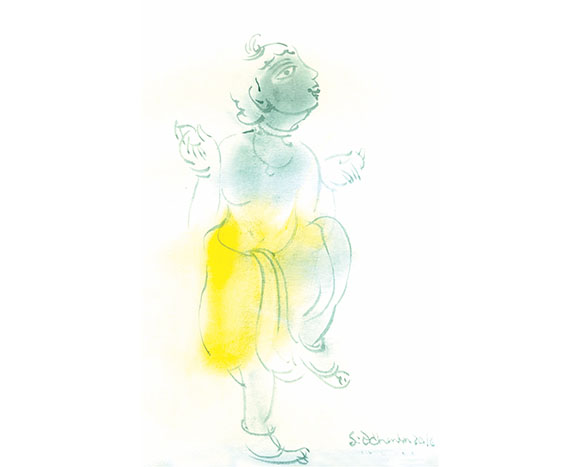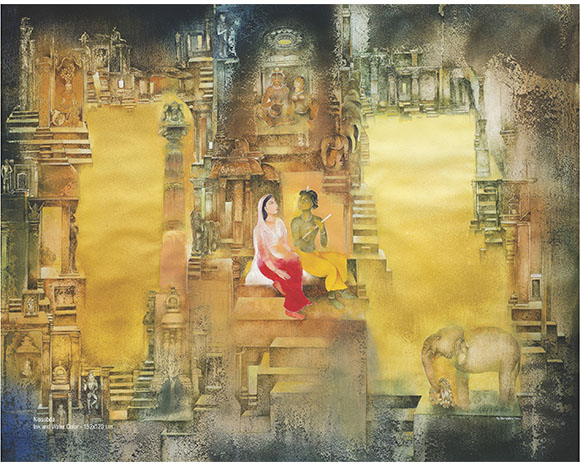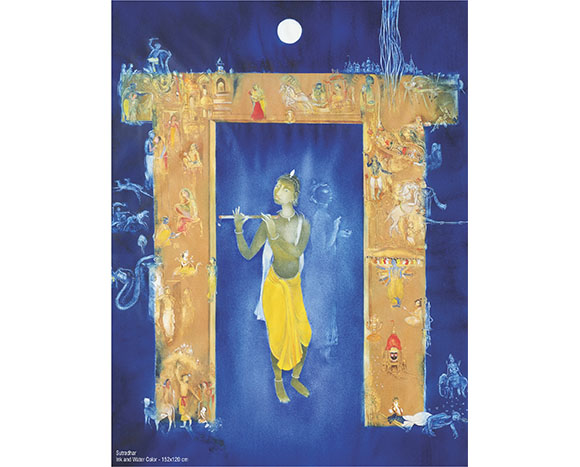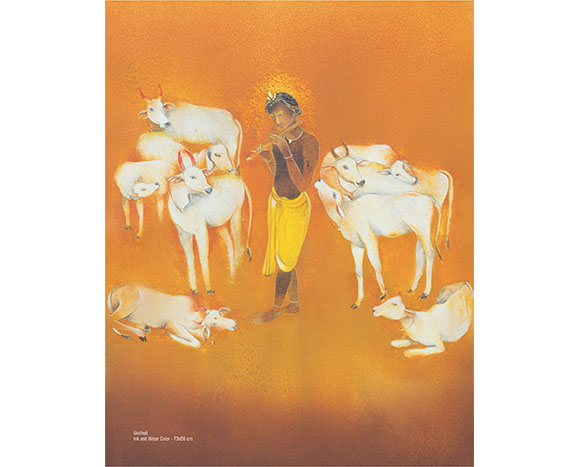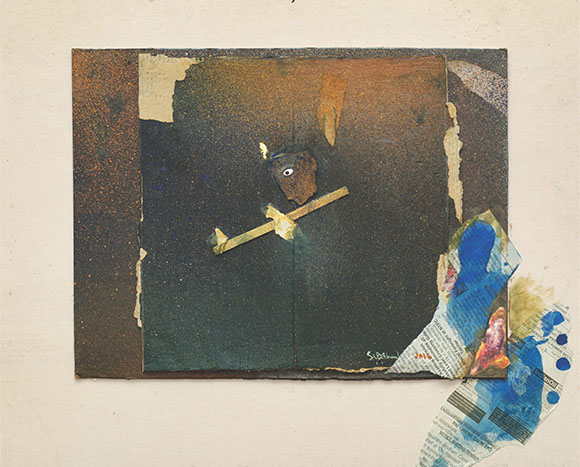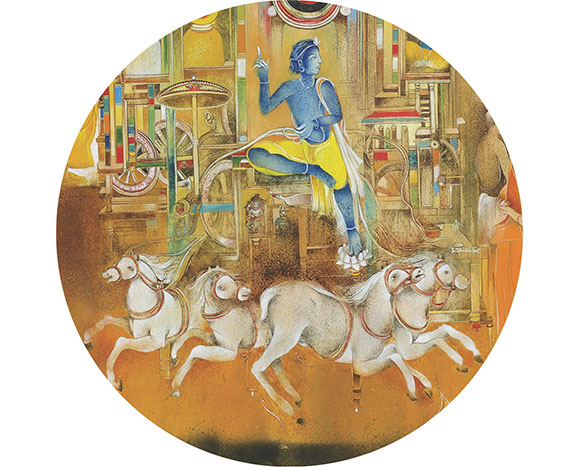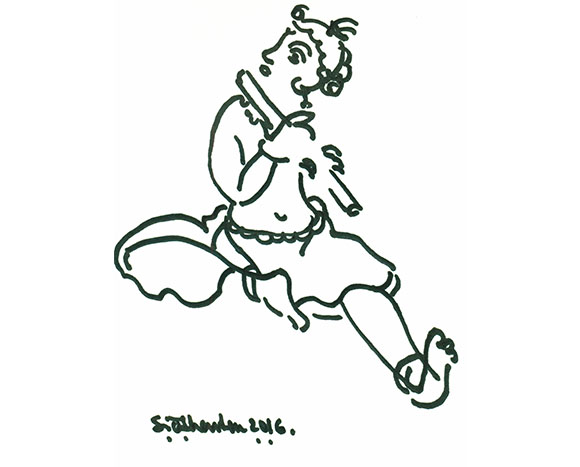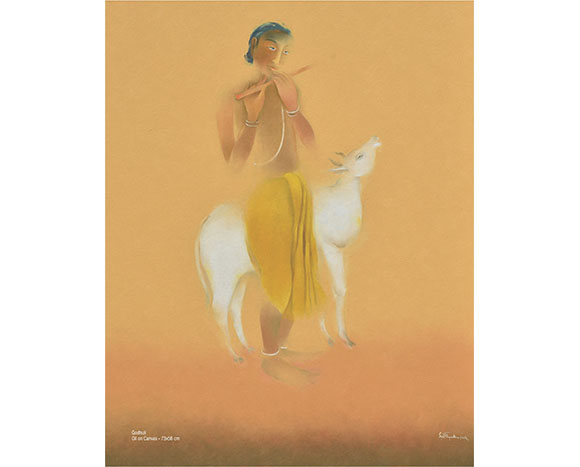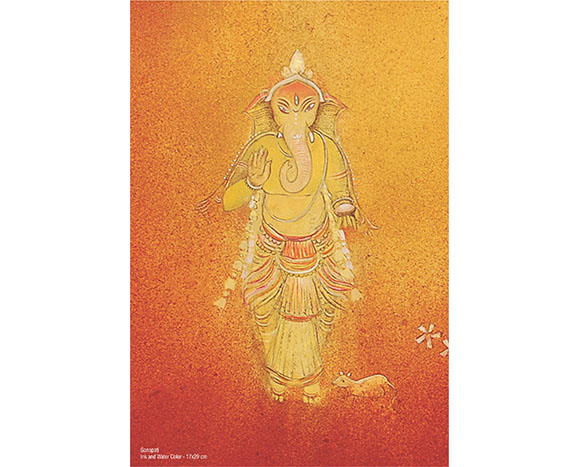
TRANSCENDENTAL SPIRITUALITY
PAINTINGS OF SIDDHARTHA SENGUPTA
Mrinal Ghosh
Spirituality is the primary mode of the paintings of Siddhartha Sengupta. Truly speaking, every art is the expression of some sort of spiritual sensibility, as it helps to transcend the mundane existence. Art develops out of the artist's imagination. Until the imagination flowers into a kind of transcendence, no art is possible. 'The act of imagination is a magical one', said Jean Paul Sartre in his book 'Psychology of Imagination'. And then he continued: 'It is an incantation destined to produce the object of one's thought, the thing one desires, in a manner that one can take possession of it'. This 'incantation', which is magical in nature, develops out of some spiritual subjectivity.
In this sense spirituality may be theistic or atheistic. When an artist lashes the social or natural system, when he rebels against the conventional settings, he does it from a conviction or commitment that also contains some sort of spirituality, albeit of atheistic trend. The 'Guernica' or 'Cry' of Picasso or the work of Edward Munch like 'The Scream' 0r the sculpture 'Pather Panchli' by Somnath Hore based on famine of 1943 are examples of such kinds of rebellious spirituality. In paintings of Rabindranath submission to the divine is very minimal in comparison to his verses of 'Geetanjali' or songs. Yet there is transcendence of a very high order, which is an expression of spirituality. But the spirituality of the works of Far Angelico or Botticelli or our Kshitindranath Majumder or Nirad Majumder is something class apart. They are theists and submit themselves to the divine spirit controlling the creation.
The spirituality of Siddhartha Sengupta, who was born in 1958 and took his art education from College of Visual Arts, Kolkata under the guidance of the famous painter Shubhaprasanna, may be categorized towards this trend. He submits his faith to the supernatural that takes a worldly form, wherein comes his notion of myth. He transmutes the infinite into an earth-bound symbol, eternity into temporality. The divinity thus flows over the existence. 'Krishna' is the symbol both of his devotion and transcendental passion. In Indian mythology, particular in Bengal Krishna emanates from two ways of life and world outlook. In Geeta Krishna presents himself as an omnipotent superpower, the guiding force of the creation and destruction of the universe. In other trend, which is mainly folk in nature, Krishna is the village youth; all of his youthful passion is dedicated towards the love of Radha. But the myth of Krishna and Radha does not end in physical passion only. It transpires into a delighting power, 'hladini shakti' in classical Indian language, which is the root cause of procreation, generation and regeneration. These two concepts of Krishna, idealized classical and romantic folk ultimately unite to form the complementary nature of the universal motive-force of creation.
Sengupta submits his devotion and creative zeal towards both these trends. He rather unites these, assimilates these two aspects of transcendentalism to build up his own philosophy of expression. His subject and theme is not limited, however, within the depiction of Krishna alone. As a source of divine power he depicts Durga, Kali, Laxmi, Saraswati, jagannath, Ganapati, Buddha and other mythical and historical divinities. His aim is to enlighten the natural through imposition of supernatural, ultimately to find the resurrection of life. In the introduction to the series of the paintings titled 'Atmika' of 2008-09 he said, 'The divine images of the mother mesmerize me and transport me from the transient world to the transcendental'. Yet Krishna becomes his prime inspiration, main source of his paintings. He wants to unveil the peace, where he brings Buddha and Ashoke also in association with Krishna.
His mother has been the prime inspiration of his life. Her religious devotion, creativity in needle work and other household performing, the aromic vapor that surrounded the environment around her daily worship of household gods and goddesses used to create an abounding wondrous inspiration in the imagination of child Siddhartha. His father was also the source of great inspiration to him. His relentless support towards his artistic creativity induced Siddhartha towards a faith that transpired into a spiritual light to lead him towards his art.
Modernity in Indian painting took a new turn since the beginning of the twentieth century, when a nationalist sensibility turned to be a guiding force of creativity as a rebellion against the first phase of modernity that started since 1850-s and developed into academic naturalist style of execution following the British school, that marred the national identity of our art. Neo-Indian School initiated by Abanindranath Tagore and extended by his disciples like Nandalal Bose and others sought a national identity of our modernity, where classical and folk idioms of ancient and medieval art were transformed into contemporary setting. The movement built up a strong base for modern and modernist development of our art, where global values flowered out of a local identity. The form and aesthetic of this school have not been exhausted but transformed in different directions till the present time. The paintings of Sengupta have been generated out of that legacy.
Krishna has been a very popular theme in our art even in modern period. Abanindranath explored it in his 'Krishnalila' series of paintings of 1897 and 'Krishnamangal' series of 1938. Nandalal Bose and other artists also dealt with this subject in various ways. Sengupta is an artist who has come to his own form during 1980-s. The concepts and technicalities of his paintings have developed extensively during the next decade. Sengupta through his sincere and untiring perseverance has acquired the finest dexterity in his execution. Actually in art technique builds up the form, which in turn illuminates the concept. Though he often uses oil, yet water colour is his primary medium. He has developed his water colour and wash technique with addition of ink in such a way that within the transparent luminosity and translucence, it transpires a strength akin to the effect of tempera, which ultimately gives rise to a meditative environment. He once said of his own technique, 'I try to discover a surface to mix ink with water colour, so that a light can emerge from surface of painting'. In case of oil he added, 'again to keep colour under oil I draw a level in upper layer'. The chromatic treatment of his space that often disintegrates it in various planes gives rise to a structural effect elevating the traditional treatment into a modernist value. Thus the treatment of mythical chronicles gets a contemporary significance. In his drawings the vast spatial void around the minimally delineated subject turns into a symbol of eternity within which myth or life manifests itself. With all these he creates a space of peace and tranquility against the ubiquitous turmoil of life.
Title : Krishna Yoga
Size :
Medium :
Year : 2014 - 2016
Title : Krishna
Size :
Medium :
Year : 2016
Title : Krishna
Size :
Medium :
Year : 2016
Title : Krishna Rat
Size : 90 X 120 cm
Medium : Ink & Water Color
Year : 2016
Title : Details of Nissabda
Size :
Medium :
Year : 2016
Title : Nissabda
Size : 152 X 120 cm
Medium : Ink & Water Color
Year : 2016
Title : Sutradhar
Size : 152 X 120 cm
Medium : Ink & Water Color
Year : 2016
Title : Radha Krishna
Size : 95 X 97 cm
Medium : Ink & Water Color
Year : 2016
Title : Details Krishna Yoga
Size :
Medium :
Year : 2016
Title : Krishna Yoga
Size : 178 X 117 cm
Medium : Ink & Water Color
Year : 2016
Title : Godhuli
Size : 73 X 56 cm
Medium : Ink & Water Color
Year : 2016
Title : Pre-Historic
Size : 50 X 46 cm
Medium : Mixed Media
Year : 2016
Title : Navakalevar
Size : 152 X 120 cm
Medium : Ink & Water Color
Year : 2016
Title : Details Navakalevar
Size :
Medium :
Year : 2016
Title : Krishna Katha
Size : 75 X 55 cm
Medium : Ink & Water Color
Year : 2016
Title : Gopal
Size : 16 X 13 cm
Medium : Drawing
Year : 2016
Title : Gopal
Size : 60 X 48 cm
Medium : Ink & Water Color
Year : 2016
Title : Krishna Katha
Size : 100 X 99 cm
Medium : Ink & Water Color
Year : 2016
Title : Godhuli
Size : 73 X 56 cm
Medium : Oil on Canvas
Year : 2016
Title : Radha Krishna
Size : 73 X 56 cm
Medium : Oil on Canvas
Year : 2016
Title : Aratrik
Size : 97 X 87 cm
Medium : Ink & Water Color
Year : 2016
Title : Pilgrims
Size : 242 X 191 cm
Medium : Oil on Canvas
Year : 2016
Title : Shree Krishna
Size : 152 X 127 cm
Medium : Oil on Canvas
Year : 2016
Title : Ganapati
Size : 17 X 29 cm
Medium : Ink & Water Color
Year : 2016


